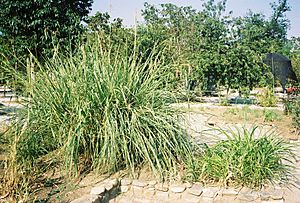Teosinte facts for kids
Quick facts for kids Teosinte |
|
|---|---|
 |
|
| Two teosintes | |
| Scientific classification | |
| Kingdom: | |
| (unranked): | |
| (unranked): | |
| (unranked): | |
| Order: | |
| Family: | |
| Genus: |
Zea
|
| species | |
|
Z. diploperennis |
|
The teosintes are a group of wild grasses. They are found in places like Mexico, Guatemala, and Nicaragua. These plants belong to the genus Zea. You might be surprised to learn that teosinte is the wild ancestor of the corn (or maize) we eat today!
Contents
Discovering Teosinte: The Wild Corn Cousin
Teosinte plants look a lot like corn, but they have some big differences. Instead of large, soft kernels, teosinte has small, hard seeds. These seeds are covered in a tough shell. There are five main types, or species, of teosinte. They include Zea diploperennis, Zea perennis, Zea luxurians, Zea nicaraguensis, and Zea mays.
Where Teosinte Lives
Teosinte grows naturally in warm, tropical areas. You can find it in the highlands of Mexico and Central America. It often grows in fields, along roadsides, and in other open spaces. These plants love sunshine and good soil.
Teosinte and Corn: A Family Story
Scientists believe that all modern corn came from a type of teosinte. This happened thousands of years ago. Ancient people in Mexico started to grow and change teosinte. They picked plants with bigger, softer seeds. Over many, many years, these small changes added up. This is how the corn we know today was created.
How Teosinte Became Corn
Wild teosinte plants have many branches. Each branch has a small ear with only a few hard seeds. Early farmers slowly changed these plants. They selected plants that had fewer branches and bigger ears. They also chose plants with softer seeds that were easier to eat. This process is called domestication. It turned a wild grass into a major food crop.
Why Teosinte is Important Today
Even though we eat corn, teosinte is still very important. It holds special genes that modern corn might not have. These genes can help corn plants resist diseases or grow better in different weather. Scientists study teosinte to find these useful genes. They can then use them to make our corn crops stronger and healthier. This helps make sure we have enough food for everyone.
Protecting Teosinte's Future
Because teosinte is so valuable, it's important to protect it. Many types of teosinte are wild plants. Their natural homes are sometimes threatened by human activities. Protecting these wild relatives of corn helps keep the genetic diversity of our food supply safe. It's like keeping a library of useful plant traits for the future.
Images for kids
-
teosinte (top), maize-teosinte hybrid (middle), maize (bottom)



